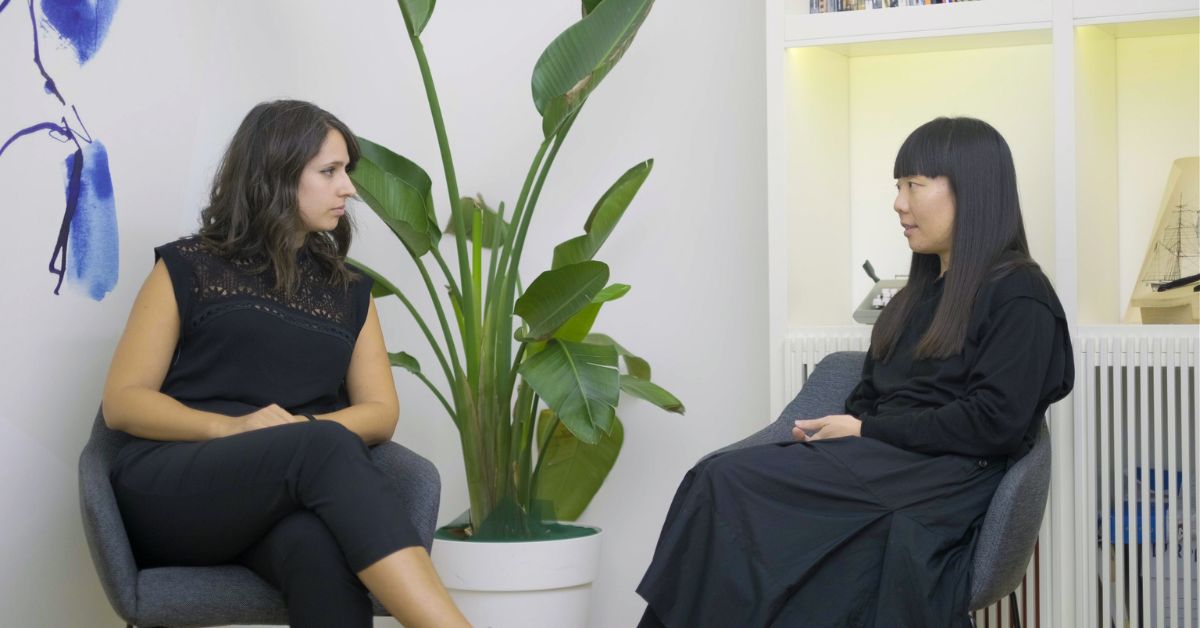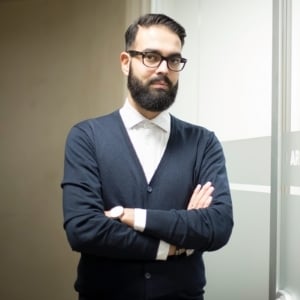Architectural Talks, the interview series by Manni Group in collaboration with YAcademy, meets Melodie Leung, Associate Director of Zaha Hadid Architects.
In this article you will find
Zaha Hadid Architects
Zaha Hadid has been one of the most influential figures in contemporary architecture. Born in Iraq in 1950, with a degree in mathematics under her belt, she moved to the UK in the 1970s to study architecture; there she met the leading architects of the time, Rem Koolhaas and Elia Zenghelis.
Hadid was the first woman to win the Pritzker Prize, considered the Nobel Prize of architecture, in 2004. Her distinctive style is characterised by fluid shapes, sinuous curves and a strong sense of dynamism, which are reflected in many of her most famous designs. They include the Vitra Fire Station in Weil am Rhein, the MAXXI National Museum of 21st Century Arts in Rome, the Guangzhou Opera House in China, and the London Aquatics Centre designed for the 2012 Olympics.
Zaha Hadid Architects continues to be one of the most important players in the world of contemporary architecture, with ongoing projects all over the world, from Brazil to Saudi Arabia.
The interviewee: the visionary Melodie Leung
Melodie Leung has been Associate Director at Zaha Hadid Architects since 2019. A graduate of the University of Illinois (class of 2002), she subsequently completed a Master of Architecture at the Graduate School of Architecture, Preservation and Planning at Columbia University.
Leung has led the implementation of projects that range from urban contexts to architecture, interiors to product design. The latest project she completed as project director is “The Kensington”, the first ever sculptural billboard within the Royal Borough of Kensington, Chelsea, that enhances the public realm.
She has also contributed to ZHA’s research on sustainable technologies and has been involved in projects such as the King Abdullah Petroleum Studies and Research Centre in Saudi Arabia and the Novorossiysk urban regeneration project in Russia.
Manni Group’s interview with Melodie Leung of ZHA
Manni Group.: Zaha Hadid Architects is obviously one of the most famous architectural firms in the world and because its design is deeply rooted in parametric designwe wanted to have a better understanding of how it relates to the construction industry's need for standardised processes.
Melodie Leung: I believe we have developed the concept and approach of parametric design for many years, and what we do is bring parametric design to integrate all this information from the construction industry to bridge the gap between design and construction.
On the one hand, we can use parametric design to improve our designs with regard to environmental information in terms of sustainability, solar gain, wind forces and all these local inputs. We can also use it to incorporate information about the building's surroundings. So... let's say, flows of people, as an analysis of the nearby urban centre.
We can also include input from the construction industry, such as standardised units of timber construction. What are the standards for steel construction? What are the ranges of certain types of new manufacturing methods? We can incorporate all this and use it to optimise our design process.
M.G: Fantastic! You just mentioned sustainability... in many cases Zaha Hadid Architects' projects are obviously linked to particular aesthetics and it is the first thing that comes to mind when thinking about the project. How does sustainability relate to design processes at the firm?
L: Today it is clear that, as architects and designers of the built environment, sustainability is by far the most important responsibility. It is the biggest concern we face on the planet, and of course the projects we have worked on have always focused on addressing movement, bringing many different factors and multiple perspectives into the project. This approach also lends itself to design with sustainability as the central element.
The first design decisions we make have a significant effect in terms of sustainability: from the orientation of the building, to the amount of material needed for the structure, to shading... all these factors can be addressed in a very sophisticated way.
M.G: Most of the projects you have followed are characterised by a high level of complexity, and in your projects it is necessary for the different elements to be assembled on site... In your opinion, how could off-site technologies represent a valuable opportunity for architects and architectural firms in their future projects?
L: We have actually done a lot of work on off-site prefabrication possibilities. For example for a project we are working on in Miami, for the tallest tower ever built, we are using this type of technique where the modules are built in factory. The tower has a complex, beautiful and elegant structure, and the elements were shipped onsite while the concrete and reinforcement were cast on site.
So this type of hybrid strategy is a really interesting possibility when it comes to designing what is available locally and considering the quality and cost of building a project.
We also have research teams that study what is available in the industry. For example, looking at wood and what the standardised units are in the glulam industry, to create toolkits for designers to be able to design by optimising what is available on the market and what the design possibilities are.
M.G: On this topic, in the previous conversation you emphasised the importance for young architects to be able to use tools and software to create and relate to the project itself. For me, it is also interesting to better understand the relationship between off-site construction and technologiesand the importance you give to the use of design software and have it as a kind of reference scheme.
L: Yes, I think our teams are very capable and able to analyse, simulate and design in a digital, and therefore virtual, environment.
More and more often we see projects being delivered and coordinated within a 3D space, a digital environment connected to all the various consultants.
In addition, we greatly customise our design tools so that we can integrate more input from the construction industry, environmental analysis, flows of people and the way people move and congregate in a space, so that we can optimise the layout of an office floor plan to increase collaboration.
There are so many different aspects that we can combine in our tools. What is really exciting for us is that we can now see that these possibilities are truly increasing and a whole generation of architects is also developing skills to use the technology more and more, with wide-ranging effects.
M.G: And how do you think technology will influence the daily work of future architects even more?
L: This is a very good question. We are evaluating it every day. We are really excited about what artificial intelligence is offering in terms of processing power, because there are many different fronts within the industry. Our designers are experimenting with some of these innovations and we see AI as a very useful new type of interface for conceptualising, designing and communicating.
At the same time, we are already using it to simulate and analyse. Now we can build a framework, whereas before it might have taken us a day to study a single option.
Now, if we build a framework, we can test a hundred options and run the tests overnight, then we can simulate numerous possibilities and strategically choose the ones that offer the most for the users and the final design.
M.G: It has been seven years since the passing of the founder of Zaha Hadid, how do you feel about the fact that her philosophy and inspiration are now linked to your daily life and the daily work of other designers, who are also related to these kinds of trends and changes that take place every day in the architecture industry?
L: Zaha founded the firm based on the potential of diversity and collaboration, and I find that we are truly fortunate to be part of this vision, which on the one hand inspires many designers of the new generation, and on the other hand is also a firm that truly celebrates the potential of each and every designer on the team.
So, over all these decades, it has created a team that has produced a vast repertoire of buildings, projects, but it has also built an atmosphere of strong collaboration and I believe it is an environment that seeks and nurtures the potential of young designers.
And that is the only way our art continues to grow and evolve and remain relevant, because I think the world is changing faster and faster than ever before. And so, through this collaboration and the acquisition of a wide range of talent and experience, we can remain relevant in an ever-changing world.
M.G: During your lecture you also emphasised Zaha Hadid's background as a mathematician and scientist. From a mathematical perspective, how do you think these elements have influenced not only the philosophy, but also the architectural firm's approaches to creation?
L: If I can put it simply, I believe there are two aspects that characterise Zaha's values and that have been incorporated into the firm. And then, I would say that Patrick Schumacher, who worked very closely with her for many years, shares this view on the potential offered by technology. He is very philosophical about what architecture can do for society.
So, I would say that Zaha, having studied mathematics, had always been very logical in creating a frame of reference. And I think that as an architect, as a designer, we have to look widely at the world around us for inspiration, but at the same time be able to direct the design process and create frames of reference.
We create theses to understand how to approach the design process and then we have to work rationally to decide which direction to take. On the other hand, I think Zaha had an optimistic view of the human spirit, and was very sensitive to how architecture can shape our lives, how it can inspire people, how we can unite them and improve the sense of civic belonging and quality of life for those who live and work in buildings.
Manni Group: Thank you very much Melodie.
Melodie Leung: Thank you for having me.


